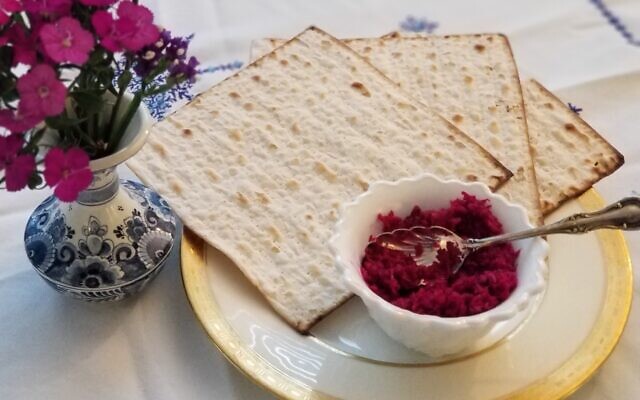Homemade Horseradish
Flora Rosefsky shares her cousin Judy Lizzack’s homemade horseradish recipe.
Before tasting my cousin Judy Lizzack’s homemade horseradish, I thought the supermarket variety jars of horseradish put out during the festival of Passover were bitter enough to remind us that we were once slaves in Egypt thousands of years ago. I still made the “Hillel Sandwich,” combining sweet haroseth (fruits and nuts mixture) with the horseradish on matzah during the seder. If I opted for straight horseradish, my eyes and those of others would literally water and even burn.
Lizzack uses the raw horseradish root for her seders. Her prepared horseradish, made with sugar, primarily accompanies the traditional gefilte fish course during the seder, throughout the week or with roasted meat dishes. But I use it during the haggadah reading.
When visiting the Lizzacks one year, I took a look and taste of her sought-after homemade horseradish recipe, handed down by four generations from her husband’s family without any written instructions. Before COVID, Lizzack put her 10 pounds of horseradish into small jars to be given out as Passover gifts to family and friends to use for their seders, including her Orthodox rabbi in Fair Lawn, N.J.
What follows is my cousin’s recipe now written down for prosperity.
3 pounds fresh white horseradish
4 large or 5 medium red beets
2 lemons, slices or wedges with skin
½ cup sugar
1 tablespoon kosher salt
Fill large pot with 2 quarts of water.
Peel and cut beets into about 1-inch cubes.
Place beets in water and boil for 10 minutes.
After the 10 minutes, add lemon, sugar and salt.
Boil another 10 minutes.
Note: While the beets are cooking, set up multiple lit candles of any size or shape on counters on each side of you when working with the raw horseradish. “The flames will reduce any tears 100 percent,” Lizzack said.
Peel and cube horseradish and place in bowl.
When beets are ready (test with fork for tenderness) use a large glass measuring cup to scoop out about 10 pieces of beets with a little juice. Too much liquid may make it overflow when processed.
Place beets in food processor along with three handfuls of the cubed horseradish.
Blend using processor’s metal blade. As you blend, you can add a little more beet juice.
Blend until consistency and color is what you like. Adding more beets and juice makes the mixture darker. Do not let any white horseradish pieces show through.
In making 3 pounds, you may need to repeat this process two more times.
Tips: When you open the processor, do not put your nose over it to smell.
Place the mixture in another pan or bowl and cover till ready to put in individual jars. My cousin suggests using glass canning jars with seals. And when putting the mixture into the jars, hold a candle in your left hand to prevent the shutting of your eyes, she said.
The jars can stay refrigerated for several weeks after Passover and freeze well in the canning jars for up to a year or more. Lizzack said, “Even if you use the frozen horseradish mixture, to defrost for Rosh Hashanah or Chanukah, the ‘heat’ should remain.”




comments